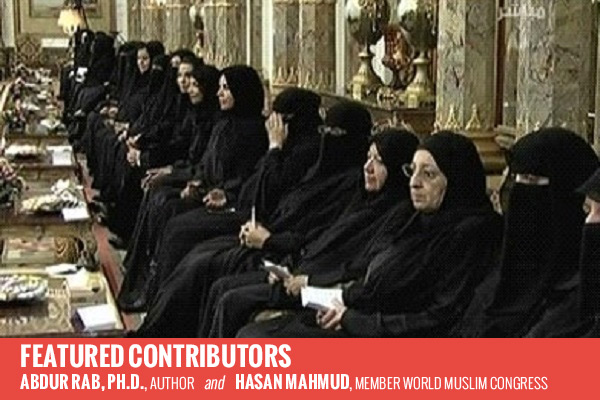
7 Reasons Why Wearing the Hijab to Express Solidarity With Muslims Isn’t Right
- By Abdur Rab --
- 20 Jan 2016 --

Featured Contributors Abdur Rab and Hasan Mahmud give seven reasons not to participate in World Hijab Day.
Ruth Graham’s recent Atlantic article highlights the point that “it was her [Professor Larycia Hawkins] theology – not her hijab – that got her in trouble with the evangelical college.” Her only offense was that, as a Christian, she believes that Christians and Muslims worship the same God, as Pope Francis says, and that she stands in solidarity with her Muslim neighbors.
7 Reasons Why Wearing the Hijab to Express Solidarity With Muslims Isn’t Right[/tweetthis]
Like Hanna Yusuf and Nusrat Qadir, many Muslim women do not feel they’re oppressed when they wear the hijab. But the real problem is that many of them deluded to believe that they wear it because Islam so demands.
World Hijab Day is a hideous political agenda. It’s a day when Muslim women – even non-Muslim women – are asked to wear the hijab in solidarity with the hijab-wearing Muslim women. As Asra Nomani and Hala Arafa demonstrate in their recent Washington Post article, the hijab has no basis in Islam and that it’s a well-funded political ploy of conservative Muslims “to dominate modern Muslim societies.”
We, as committed Muslims liberated from the roots of a conservative Bangladeshi religious background, believe in freedom of religion or culture and in universally recognized human rights. We’ve no problem whatsoever with the hijab if it simply and purely represents the personal choice of the wearer. However, we’re strongly opposed to wearing it as an act of solidarity for Muslim women. Here’s why.
First and foremost, wearing the hijab as an act of solidarity for Muslim women is tantamount to siding with Muslims who disingenuously promote this dress as a religious requirement – even as a political agenda. Neither the Quran nor the Hadith mandates the hijab as an essential Islamic dress. The hijab now usually refers to the headscarf, but is sometimes used in an inclusive sense also to include the niqab or burqa (full-body veil with eyes uncovered or covered).
The Quran requires women to guard their modesty, covering their private parts and bosoms, and not to display their beauty except what is ordinarily apparent and not to strike their feet so as to reveal their hidden beauty except to some specified close relatives (24:31). Here the expression “what is ordinarily apparent” is usually taken to mean the face, hands, and feet. It can also mean the head or hair. Note another directive of the Quran:
33:59 O Prophet, advise your wives, your daughters, and the women of believers to draw their outer garments (jalabib) over themselves. That will be better, so that they may be recognized and not troubled.
This verse asks women to wear outer garments (jalabib; sing., jilbab) so that they are recognized and not troubled. This implies that the dress needs to be dignified and decent-looking so that it is more likely to inspire respect rather than undue gestures on the part of onlookers. Ironically, however, conservative Muslims misinterpret this verse to mean that the hair, the face, and the eyes also need to be covered by the jilbab.
The Quran urges both men and women to lower their gaze and guard their modesty (24:30-31). The veil supporters seem to ignore the implication of these verses: If women needed to cover their faces and hair, then this verse would have become irrelevant. Verse 24:31 asks Muslim women to draw their khemar over their neck, which does not mean the hijab that traditional women wear. In fact, the Quran nowhere mentions the hijab as clothing, but mentions it as a curtain or barrier that was applied solely to the Prophet’s wives to keep a safe and dignified distance from the believers who came to his house that was also used as a mosque. The believers were asked to communicate to his wives behind a hijab (33:53).
The Hadith provides conflicting messages about whether a full-face veil is required for women. Only some Hadith from Bukhari, Abou Dawd, and Muslim are cited below.
When the verse on the veil [33:57] had been revealed, women started covering their faces (Bukhari, Vol. 6, #282), but before all others except the Prophet (Ibid, Vol. 5, #32). When Companion al-Fadl was staring at the beautiful face of a woman, the Prophet moved his face away, but did not ask the woman to cover her face (Ibid, Vol. 8, #247). The Prophet said that when women grow in age, they should not display anything except their face and hands (Abou Dawd, #4092. If a man wants to marry a woman, he can see her face in secret (Ibid, #2077). The full-face veil was applicable only for the Prophet’s wives (Bukhari, Vol. 1, #148, Vol 6, #10 and #313, Vol. 8, 257; Muslim, Book 26, #5397).
Second, requiring Muslim women to dress in some specified way, as John L. Esposito notes in one of his books, is often seen as a reflection of men controlling women – “a symbol of women’s inferior status.” Many Muslim scholars also do not consider the veil to be an essential Islamic dress. As the Independent columnist Yasmin Alibhai-Brown, who titles her article as “As a Muslim woman, I see the veil as a rejection of progressive values,” reports, the famous Egyptian jurist, judge, and feminist reformer Qasim Amin, who wrote a trailblazer book The Liberation of Women (in Arabic) in 1899, “critiqued and repudiated the veil.” She also notes in the same article, “The Moroccan academic [late] Fatima Mernissi, Egypt’s Nawal El Saadawi and the Pakistani scholar Riffat Hassan all argued for female emancipation. They rightly saw the veil as a tool and symbol of oppression and subservience. Mernissi’s Beyond the Veil (1975) is a classic text. So too El Saadawi’s The Hidden Face of Eve (1975).”
These Muslim scholars and others such as (late) Muhammad Sayyid Tantawy, Qassim al-Ghamidi and Tariq Ramadan have declared the niqab or burqa as not required by Islam. Even the conservative scholar Zakir Naik persuasively argues that the face veil is not obligatory for Muslim women. Strikingly, Pakistan’s conservative religious consultative body, the Council of Islamic Ideology of Pakistan (CII) also rules that women are not required to cover their faces, hands, or feet under Islamic Sharia law.
‘My Hijab Has Nothing To Do With Oppression. It’s A Feminist Statement’
Not all Muslim women cover their … https://t.co/qeBy1KEuJU
— Naomi Jadotte (@YOUTUBEWEEKLY92) January 16, 2016
Third, historically, as the noted scholar of comparative religion Reza Aslan notes in one of his books (p.66), “The veil [in the sense of a clothing cover] was neither compulsory nor widely adopted until generations after Muhammad’s death, when a large body of male scriptural and legal scholars began using their religious and political authority to regain the dominance they had lost in society as a result of the Prophet’s egalitarian reforms.” The Quran forbids the Prophet Muhammad, at some point, to consider marrying any woman even though her beauty was pleasing to him (33:52). This makes it clear that women at that time could display at least their faces and hair.
Also, in the 1940s to 1960s, women in the eastern Mediterranean Arab countries, led by Egypt, did not dress in the traditional veils worn by their mothers and grandmothers. Then as Harvard divinity professor Leila Ahmed finds, to her surprise, as recounted in her 2011 book, the veils made a comeback in all forms and styles since late twentieth century – a development that has significantly to do with Saudi Arabia’s aggressive promotion of its ultraconservative Wahhabi Islam.
Fourth, even though the veil is widely viewed as a symbol of modesty and an invitation to men to treat women respectfully rather than as sex objects, it is no sure protection against sexual harassment. As Ro Waseem cites in a New Statesman article, according to a study done in Egypt in 2008, 72.5 percent of the victims surveyed reported being sexually harassed when they were, in fact, wearing the hijab. A recent Guardian report by a Tehran Bureau correspondent shows that the hijab has made sexual harassment rather worse in Iran. Still another report by an American Muslim woman says, “my most dangerous travel experiences of unwanted advances occurred in the most conservative Muslim societies that observe the strictest dress codes, even though I was covered.” All this evidence strongly suggests that the veil does not necessarily serve its avowed purpose.
In fact, the strict dress code has done little to curb clandestine sexual crimes in Saudi Arabia. A study aired in a Saudi TV channel reveals a startling finding: some 23 percent of Saudi children are victims of incest by their own relatives and some 46 percent of youths in Riyadh are homosexuals, a crime in Saudi Arabia. In addition, in this modern tech world, adult males and females can easily engage online in illicit sexual activity over Skype.
Fifth, in today’s world, while many Muslim women wear the veil, many more do not do so. This cannot be taken as proof that those who do not wear it are any less religious and righteous than their hijab-wearing counterparts. The Turkish women had long rejected the hijab and other veils as backward-looking in a secular state founded by Kemal Ataturk. The ban on the full-face niqab and burqa still stays, but that on headscarves was subsequently lifted, except for the judiciary, military and police. The Iranian women use headscarves, not full-face veils. Syria has instituted the full-face niqab ban from universities since July 2010 as part of its secular tradition. Of late, even the Saudi authority has embraced some veil reform. In 2013, it inducted women members to its supreme consultative body, the unelected, 150-member, previously male-only Shura Council, allowing them to wear the veil keeping both the face and the hands uncovered (as in the photo at the top). In landmark municipal elections toward the end of last year, women have been allowed, for the first time, to vote and contest, where women are seen with veils without the face cover. Also, importantly, Muslim women performing hajj or umrah are not required to wear full-face veils.
Sixth, there is a growing recognition that full-face veils may pose a grave security threat. As reported by BBC in June last year, Nigerian Boko Haram militants used face veils to kill more than 20 people in Chad. Daniel Pipes cites many examples where full-face veils (niqabs or burqas) were used to camouflage identity while committing crimes, which include jewelry thefts in London, Canada, and India and bank robberies in London, Philadelphia, and Bosnia. During the 2007 seize of the pro-Taliban Red Mosque, one of its leaders Maulana Abdul Aziz was caught while trying to flee in the guise of a burqa-clad woman. The Muslim extremist perpetrators of 2005 London bombings wore veils as facemasks.
After France and Belgium have banned the full-face veil – France mostly in keeping with its secular tradition and Belgium for security reasons – a growing number of African countries are instituting the face veil ban for security concern. The countries include Chad, Congo-Brazzaville, Cameroon, Niger, and Gabon. The latest African country to just join this club is Senegal. In addition, there are quite a few cities in some countries that ban the face veil in their particular areas.
Finally and importantly, the Quran’s directive to us to guard our modesty applies equally to both men and women (24:30-31). Its emphasis is on libas-ut-taqwa (clothing of moral uprightness) (7:26). Guarding modesty requires believers to maintain purity of attitude in mind, and decency of behavior with persons of the opposite sex. This is obviously more important than using a veil (burqa or hijab), which is not always found to be a good reflector of one’s decency of behavior with others. Surely, the hijab or any of its other variants does not qualify to be labeled as an essential Islamic dress, and there is hardly any valid reason for one to feel obliged to stand in solidarity with those who don this dress.
Asra Q. Nomani asks instead: Do not wear a headscarf in “solidarity” with the ideology that most silences us, equating our bodies with “honor.” Stand with us instead with moral courage against the ideology of Islamism that demands we cover our hair.
Abdur Rab, Ph.D., is a retired public policy analyst and author, Rediscovering Genuine Islam: The Case for a Quran-Only Understanding, the third succeeding two earlier acclaimed editions. His articles on select Islamic topics have appeared on World Religion News, Aslan Media, and Oped News, and include one presented to a conference at Princeton University. Follow Abdur Rab at Twitter. His website is: http://quranonly.com/.
Hasan Mahmud is a Member, Advisory Body, World Muslim Congress, General Secretary, Muslims Facing Tomorrow, Canada, and author, Sharia Ki Bole, Amra Ki Kori (in Bangla) being translated into English as How Sharia-Ism Hijacked Islam forthcoming and three movie-dramas (the making of a fourth one is in progress) that highlight the problems with the Sharia Law. His website is: http://hasanmahmud.com/.
Resources
- The Atlantic
- The Guardian
- World Hijab Day
- Washinton Post
- Independent
- Al Arabiya News
- Islamic Research Foundation International, Inc.
- IB Times
- New Statesman
- Muslim Matters
- altMuslimah
- Youtube
- BBC
- ljazeera American
- Daniel Pipes
- Amazon –What Everyone Needs to Know about Islam
- Amazon –No god but God: The Origins, Evolution, and Future of Islam




















